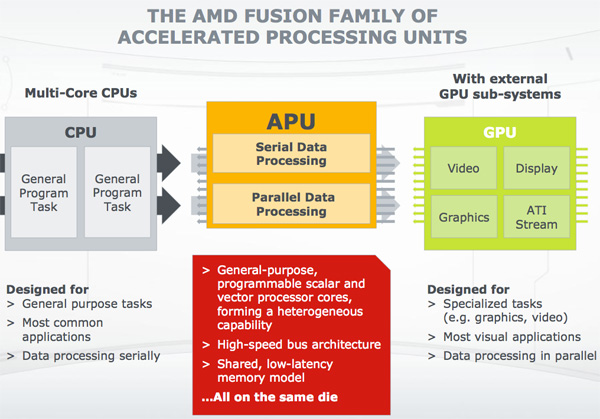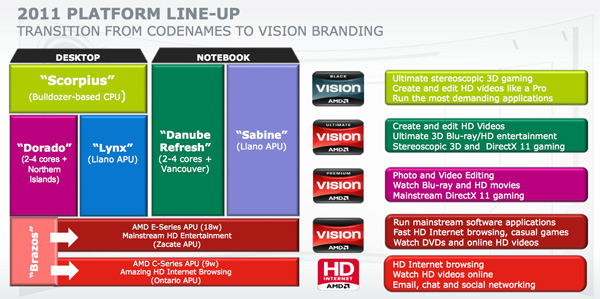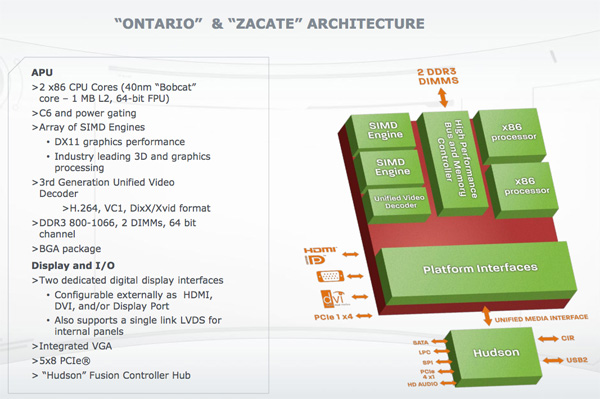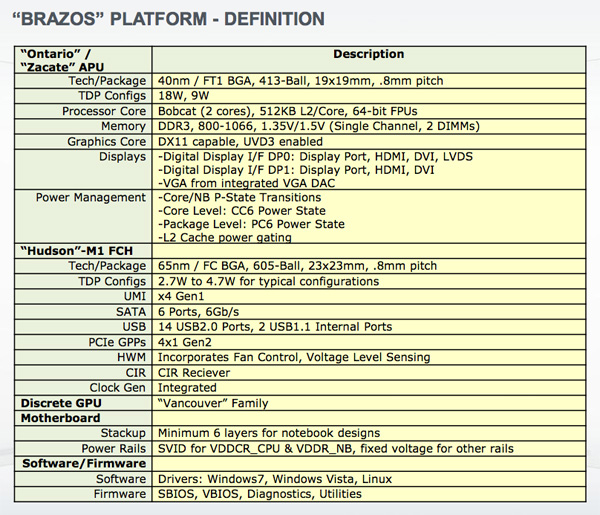Previewing AMD's Brazos, Part 1: More Details on Zacate/Ontario and Fusion
by Anand Lal Shimpi on November 9, 2010 1:09 AM ESTMeet the Brazos
The platform is called Brazos. Brazos encompasses two chips: a Zacate or Ontario APU (Accelerated Processing Unit) and the Hudson Fusion Controller Hub (FCH). This is the whole reason AMD bought ATI, Zacate and Ontario are its first CPU-GPU hybrids.
While AMD is primarily targeting the netbook/ultraportable and notebook markets with Ontario and Zacate (respectively), we’ll also see nettops/desktops and mini-ITX motherboards based on Brazos. This may be the first time we see real competition to NVIDIA’s ION platform.

AMD's Zacate APU, 19mm x 19mm package, 413 balls, 75mm^2 die
Both APUs are built from the same die. Zacate and Ontario are physically identical, they just run at different clock speeds. The 40nm die is manufactured at TSMC and measures 75mm^2. The chip is very cheap to package as well. The BGA package only has 413 balls. As one AMDer put it, these chips are designed to be stamped out as quickly and as cheaply as possible.
Both are available in single and dual core versions, although the single core variant is just a dual-core chip with one core disabled to hit various market segments. Core unlocking is apparently possible, but unexpected given the target for these platforms and the amount of effort OEMs would have to go to in order to enable it.
The CPU cores are based on AMD’s first truly low power client architecture, codenamed Bobcat. We’ve discussed Bobcat in great length already, but at a high level it looks a lot like an out-of-order Atom processor without Hyper Threading. The fundamental architecture advantage should give Bobcat the performance advantage over Atom, at least at identical clock speeds.
The GPU is based on AMD’s 5000 series architecture (Evergreen) and features 80 shader cores and AMD’s new UVD3 decode engine.
The SKUs
At launch you’ll see four SKUs, the combinations and specs are listed below:
| AMD Brazos Lineup | ||||||||
| APU Model | Number of Bobcat Cores | CPU Clock Speed | GPU | Number of GPU Cores | GPU Clock Speed | TDP | ||
| AMD E-350 | 2 | 1.6GHz | Radeon HD 6310 | 80 | 500MHz | 18W | ||
| AMD E-240 | 1 | 1.5GHz | Radeon HD 6310 | 80 | 500MHz | 18W | ||
| AMD C-50 | 2 | 1.0GHz | Radeon HD 6250 | 80 | 280MHz | 9W | ||
| AMD C-30 | 1 | 1.2GHz | Radeon HD 6250 | 80 | 280MHz | 9W | ||
Zacate takes the top two SKUs, while Ontario makes up the bottom two. The difference in TDP is entirely based on the clock speed of the CPU and GPU. And here is my concern. While a pair of Bobcats running at 1.6GHz are just awesome, drop the clock to 1.0GHz and I start getting concerned about performance. AMD didn’t let us test the C-50 but I’m curious to see what the margin of victory will be over Atom at that speed.
The GPU runs at 500MHz at the high end (Radeon HD 6310) and 280MHz at the low end (Radeon HD 6250). This paired with the single channel DDR3-800/1066 memory bus that has to be shared with the Bobcat cores means you should expect sub-5450 levels of performance out of these systems. Given their price point, that’s potentially not too bad. More enticing however is the fact that these APUs gain the benefit of the driver work AMD does on its discrete cards. Finally, game compatibility should be just as good on the low end as it is on the high end - assuming you meet the minimum specs for the title you’re running.
The lack of a brand for the CPU is a bit puzzling, but graphics are where it’s at these days.














106 Comments
View All Comments
Dark_Archonis - Wednesday, November 10, 2010 - link
You're right, and as I said, the iPad is likely not the ONLY cause.However, the fact remains that netbook sales are collapsing and I don't see them improving.
mino - Thursday, November 11, 2010 - link
"Netbook" sales are collapsing for 2 reasons:1) crappy performance
2) stupid Intel restrictions
Both of which are to be remedied by Ontario ...
Dark_Archonis - Wednesday, November 10, 2010 - link
Funny you mention that, as AMD is in a similar situation. Bobcat is too power-hungry to compete with ARM, but it doesn't have enough performance to direct compete with Celerons, Pentiums, and i3s. Bobcat will have more CPU performance than Atom it seems, but to what end?AMD has Intel on one side and Apple on the other side. As I already said, netbooks are facing direct competition from the iPad. This is competition that BOTH Intel and AMD have to deal with. For laptops, i3 and i5 processors still reign supreme in terms of CPU performance, heat, and power efficiency. Sandy Bridge laptops will significantly improve GPU performance.
Intel is trying to put most of its Atom focus to TVs, HTPCs, tablets, and phones. Of course they face competition from ARM and Apple.
Atom may be too power-hungry at the moment, but future Atoms will further decrease the TDP to far below Bobcat levels.
ze_troll - Wednesday, November 10, 2010 - link
LAST TIME I CHECKED BRO I DUN THINK ANYTHING IS DIRECTLY COMPETING WITH CELERONS AND PENTIUMS BCUZ THEY R DED TEKNOLOGEES.HEY DARK_ARSCHONIS, THE YEAR 2000 CALLED, THEY WANT THEIR CPU BACK LOL
Dark_Archonis - Wednesday, November 10, 2010 - link
http://www.toshibadirect.com/td/b2c/cdetland.to?po...http://www.bestbuy.com/site/Toshiba+-+Satellite+La...
Look, CELERON and PENTIUM processors for sale. Just because they still carry old names, does not mean they are dead technology. They are Core and Core 2-based CPUs simply renamed.
Now go back under your bridge troll.
Zoolookuk - Wednesday, November 10, 2010 - link
Lots of comments here about this Vs Atom, but I think people are entirely missing the point about ultra-low power devices.First of all, what about ARM? The AMD/Intel rivalry is interesting if people still think that small devices will run Windows 7 Professional, or even OS X, but the reality is that OSes are changing. Android and most obviously iOS work differently, and I suspect that even OS X is moving much more towards GPGPU capabilities that make the CPU almost secondary.
RISC and APU designs will be far more important in the next 5 years than they were in tghe last 15 years, and because of this, Intel probably has the biggest hill to climb. AMD understood this in 2006, which is why they bought ATI.